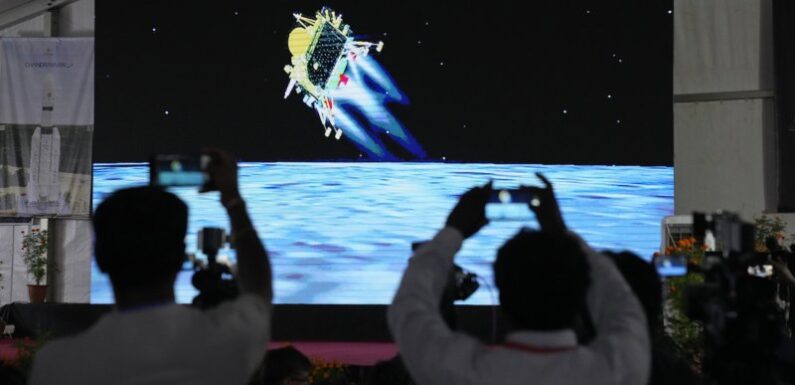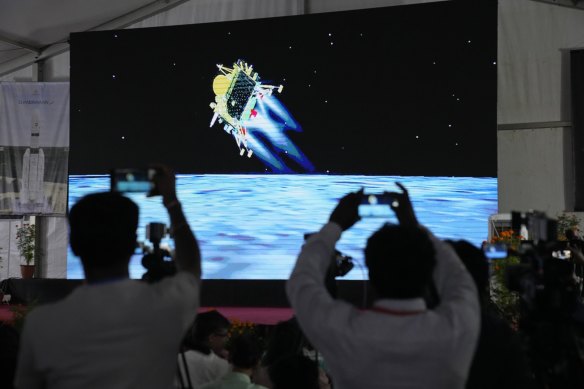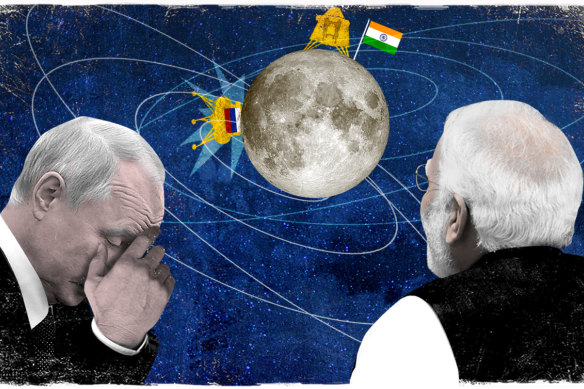
Save articles for later
Add articles to your saved list and come back to them any time.
A new space race is under way and the contrasting fate of two moonshots in the last few days provide a stark waymarker on the rise and fall of great powers.
Russia, once the globe’s foremost space power, sent an uncrewed mission to the moon and aimed to land on August 19. It crashed spectacularly. India’s moon mission, also uncrewed, lined up to land on the lunar surface four days later. It touched down successfully. The Indian moon lander released a small, six-wheeled rover which is now searching for frozen water, among other things, as a dozen nations seek ways to set up permanent lunar bases.
The live telecast of Chandrayaan-3 landing on the moon. Credit: AP
Russia’s humiliation was India’s jubilation. More so because both nations were aiming for the same feat – to be the first country to land at the moon’s south pole with the potential economic and strategic advantages that could bring. And because Russia only decided to make the attempt after India announced its plan. So Moscow raced its Luna-25 to the moon with the express intention of beating India’s Chandrayaan-3 by four days.
The contrasting competence on display is even more remarkable because Russia was once India’s senior partner in space. Delhi put its first satellite into orbit in 1975 only because the then Soviet Union carried it there on one of its rockets. Today, the student has become the teacher.
Soviet-era Russia made seven successful moon landings. But the head of the Russian space agency, Yuri Borisov of Roscosmos, said of the recent failure: “The invaluable experience that our predecessors accumulated in the 1960s and 1970s was practically lost during the interruption of the program.”
One of the most important figures in the Soviet space program, Mikhail Marov, said he was so shocked at the crash that he had to be hospitalised. “For me, perhaps, it was the last hope to see the revival of our lunar program,” said the 90-year-old.
Illustration: Dionne Gain. Credit:
By contrast, the Indian performance was impressive for three reasons, says the head of the five-year-old Australian Space Agency, Enrico Palermo, formerly chief operating officer for Virgin Galactic.
One, India is now only the fourth nation to achieve a soft landing on the moon, after the US, Russia and China.
Two, India is the first to land close to the moon’s south pole. This is technically trickier than earlier moon landings; the oblique angle of sunlight at the pole casts long and dark shadows on the lunar surface, and they’re hard for sensors to interpret and can conceal craters.
So why bother with the south pole? The early US moon missions assessed the region as dry and desolate. But in 2008, hints of water ice were detected in craters near the pole. Separately, new research estimates there could be 270 million tonnes of water trapped in tiny glass beads on the lunar surface.
If so, lunar water could support a permanent human presence, either as drinking water or broken down into oxygen for breathing and hydrogen for rocket fuel. And, if there is potential rocket fuel, the moon could be like an interplanetary petrol station, a refuelling stop and gateway for deeper space exploration.
The third impressive element of India’s mission is the bargain-basement price, which was less than half the $US200 million cost of the failed Russian Luna-25. Palermo points out that the Indian space mission cost less than it takes to make a Hollywood blockbuster movie about a space mission. The Chandrayaan-3 cost about $US74 million; Christopher Nolan spent $US165 million to make the movie Interstellar, for instance.
“They are a very capable space nation,” observes Palermo. And the head of the Centre for Air and Space Law at Mississippi University, Michelle Hanlon, says: “I see this as a shake-up in the world order.”
Indian Prime Minister Narendra Modi declared: “This is the dawn of the new India.” In the early decades of its space program, Delhi wasn’t much interested in space other than for its earthly development needs, like crop surveillance and communication and cyclone forecasting.
That changed in 2007, when China fired a missile some 800 kilometres into space and destroyed a disused weather satellite. That “resulted in an unanimous consensus that India needs to do something about protecting its own assets in space”, Rajeswari Pillai Rajagopalan, an analyst at the Observer Research Foundation, told the Financial Times.
India tested its own anti-satellite missile a dozen years later. The space race is also an arms race, as well as a commercial competition. India dramatically expanded its space program and now offers launch services to private corporations.
China’s advances also galvanised the US back into the lunar realm. In 2019, China became the first nation to land a craft on the dark side of the moon. The US, preoccupied with Mars, abruptly refocused on the moon. It’s planning to spend $US93 billion on its Artemis program to put astronauts on the moon by 2025. It would be the first time since 1972. China has announced plans to put taikonauts on the moon by 2030.
Both the US and China aim to establish bases at or near the lunar south pole, raising questions about competition for position and resources including water and critical minerals. “Does it make me nervous?” asked the deputy administrator of NASA, Pam Melroy, last year. “Yes, especially with China.”
Chinese President Xi Jinping says that making China a space power is “the eternal dream”.
The moon is about to become busy, and not only with nation states’ missions. An analyst with NSR space consultancy, Dallas Kasaboski, has estimated there are more than 400 public and private lunar missions planned between 2022 and 2032, up from a forecast made just a year ago of 250 over the same time span.
Australia is not a space power. It is finding modest niches in the programs of the frontier powers. The Australian Space Agency is building a rover for NASA to experiment with extracting oxygen from the lunar soil, for instance.
Palermo describes Australia as an “emerging” space nation. And while the leading powers in space, as on the earth, are the US and China, the evidence of the last days is that Russia is a declining power and India is on the ascendant.
Peter Hartcher is international editor.
Most Viewed in World
From our partners
Source: Read Full Article

